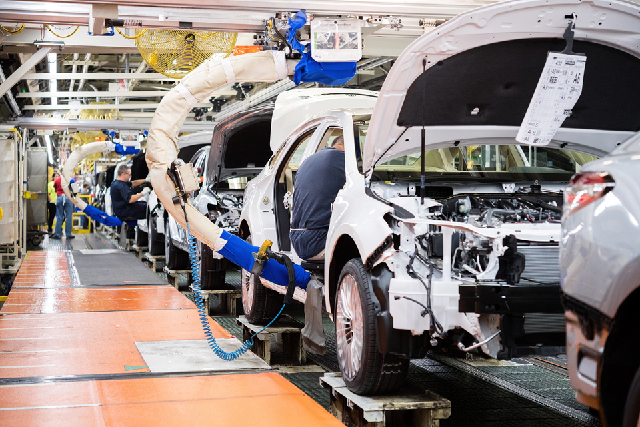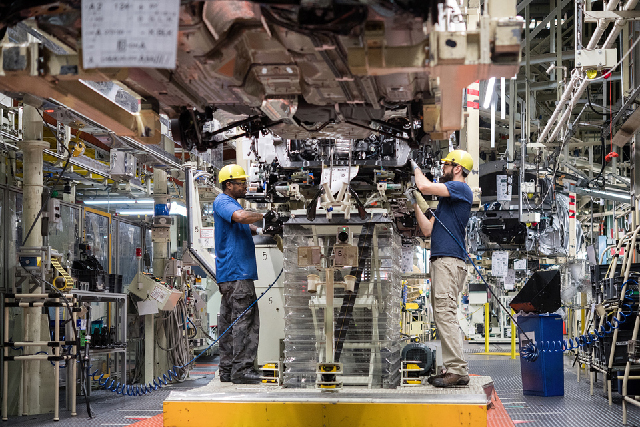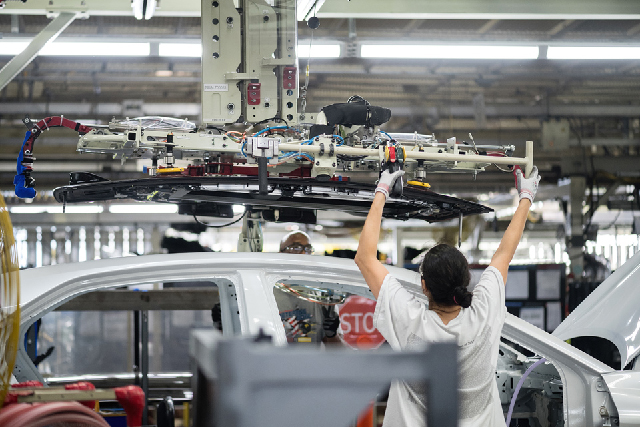Driven to improve workplace safety and comfort for autoworkers
From massaging leather seats to intricate climate control capabilities, new cars offer an array of features with driver and passenger comfort in mind. But what about the comfort and safety of the people building those cars?
The auto assembly line is the focus of alumna Katie Grosteffon, S.B. ’09, senior consultant and ergonomic specialist at Humantech. She is implementing a proactive ergonomics program at a major automaker.
Grosteffon, an engineering sciences – biomedical engineering concentrator at the Harvard John A. Paulson School of Engineering and Applied Sciences (SEAS), studies vehicle parts and identifies design issues that could impact worker comfort and safety.
A certain part may require a worker to reach too far to comfortably install it, or perhaps setting the part into place demands excessive force that increases a worker’s risk of injury.
“By trying to identify those issues long before the production starts, we can make changes to the car itself during the design process so those ergonomic concerns never actually hit the assembly floor,” she said. “This is important because, in the costly vehicle development process, the earlier we can get into the process, the more likely it will be that we can make changes.”

Workers install parts as cars move along the auto assembly line. (Photo by GLINT Studios.)
For Grosteffon, a Midland, Mich. native, curiosity about a product’s components runs deep; in her earliest childhood memory, the toddler attempted to dismantle one of her mechanical toys to see how it worked.
The puzzle-solving aspects of science and engineering appealed to her, and she opted to concentrate in biomedical engineering at SEAS so she could apply her passion for tinkering to help others.
An internship at General Motors piqued her interest in ergonomics. Grosteffon was tasked with updating the booklet that showed all standardized work in the body shop, which involved photographing every step of the process.
“I got to spend a lot of time with the operators on the job and they showed me exactly how they performed each task. I learned how a car body was built, step by step,” she said. “That experience showed me that I could use my engineering skills to improve life for people in the workplace.”
Grosteffon earned a master’s degree in biomedical engineering, with an emphasis on ergonomics and rehabilitation, at the University of Michigan, then accepted an consulting job at Humantech. Her first assignment was in-house ergonomic expert at an oil and gas company’s headquarters, where she sought to improve the workplace for office staff.
She sat with employees at their desks, studying their body position throughout the day and making recommendations to help them avoid discomfort or injuries.
“If you don’t have your desk set up correctly, usually your static posture ends up being a non-neutral posture. Over time, that can damage muscles, ligaments, and the spinal cord, even to the point where you become injured and require a lot of health care,” she said. “The goal of ergonomics is to put you in a position where you are going to be the most productive, but also the least damaging on your body.”
The biggest challenges involve helping the people on opposite ends of the spectrum; fitting workers who are extremely tall or short to a desk often requires special equipment or creative accommodations. Cost is a major obstacle in any ergonomics program, she said.
“We are trying to convince leadership to spend money now to save some kind of nebulous amount of money in the future,” she said. “It can sometimes be hard to even make those small changes that you know are going to improve someone’s life.”

Identifying ergonomic concerns not only improves comfort and safety for these workers, it also has a measureable impact on the bottom line. (Photo by GLINT Studios)
Cost is an even greater concern in her current role, since automobile design changes can be extremely costly, especially after production has started. Identifying ergonomic concerns early in the design process not only improves worker comfort and safety, it has a measureable impact on the bottom line.
For instance, a part that is difficult for a worker to install could require a lot of time on the assembly line. Improving the part from an ergonomic point of view could improve productivity. But ergonomic recommendations involve an intricate balancing act, since every part is designed for a specific purpose. For instance, a part may require a high push force to install because it must be extremely secure for air bag deployment.
Grosteffon’s experience at SEAS working on engineering design projects and her senior thesis helped her understand the different aspects of a problem and the importance of identifying key stakeholders, soft skills she relies on to effectively collaborate with design and quality engineers.
New technology plays a large role in her work, too. Each new car model requires more parts, leading to additional space and clearance concerns that could impact workers. Still a puzzle-solver at heart, she enjoys finding ways to pack more into a car, while ensuring it can still be built effectively.
“When we can make a difference, it has the potential to impact thousands of people who work hard everyday,” she said. “When we are able to make a change to a part that has been a problem across all the different plants for a really long time, seeing that solution implemented and the impact it has on the workers at those plants is really rewarding.”

(Photo by GLINT Studios)